7 Considerations - Best Furniture For Senior Living

I’ve worked with older clients and I’ve had my mother and MIL in senior living situations for some years now. I’ve seen what they all had to cull when moving into smaller homes and then what they kept all the way into assisted living. I’ve see what works and what doesn’t when downsizing.
Today, I’m sharing some tips and recommendations for furniture types that work well as an older person downsizes.
Tips for best Furniture to Invest in For Senior Living
Focus on furniture with storage capabilities.
Think tall, vertical pieces as opposed to wide and low.
Comfortable, sturdy and practical seating is a must.
Lightweight pieces that can be moved easily are important (not too bulky and heavy).
A nightstand with a large, durable top and storage is a good investment.
Furniture that does double duty is helpful.
An over-the-toilet cabinet is essential.
Drawbacks of Senior Living Apartments or Homes
Okay, I’m going to go on a bit of a rant here.
First, let’s talk about the drawbacks of many senior living situations.
When it comes to this kind of community, the investment in the buildings from the owner is going to be in the big gathering spaces, the dining area, the outdoor space.
A beautiful lobby, nicely decorated seating areas that are interspersed around the community, outdoor patios, exercise rooms, salons, etc. are going to get the biggest investment of money in terms of design, furnishing and decor.
These are the spaces they show off in their tours every day, that’s where they want to wow their visitors.
Let me give you a dose of reality here.
Most of the time a senior spends in these communities will be in their own personal space, apartment or home.
Even though communities try to get people out and about in their facility, often, most people stay in. There are many reasons why, but I have had our two mothers in 5 different places ranging from independent living to memory care and most of the times I walk in and it is a ghost town in the public areas. I’ve personally toured many more as well and found this true.
It didn’t help that during Covid, many times residents were confined to their rooms or apartments for weeks on end because of outbreaks in the community.
As someone who knows something about construction and design, I will say that the individual living spaces are the spaces where the owner of the community puts the least attention to design and quality.
I have been shocked at how inappropriate and poorly designed the bathrooms are in some of these places.
I see beautiful new grab bars and special sink arrangements for people in wheelchairs, etc. on the market and there is little of that in these places.
It is a very basic bathroom typically and they are even overly small sometimes.
In my MIL’s independent senior living home she first lived in, they had a standard 5’ tub with a shower in the bathroom.
Most of the people in that huge facility had walkers, many had wheelchairs. While my MIL is not debilitated physically and she can negotiate a tub, I don’t know how most of those residents used their showers or got in and out of those bathrooms safely.
Cabinetry in these spaces in kitchens and bathrooms are very basic, box store, off-the-shelf looking stuff. They are not that efficient for storage and are sometimes awkward to use. They have cheap drawer glides and hinges, etc. Closets are small and pretty basic.
My MIL’s sliding mirrored doors in her higher-end “luxury” assisted living residence actually fell off the tracks on top of her at one point.
This is a basic kitchenette in a very popular assisted living facility in my area.

Laminate cabinetry - typical set up in an assisted living situation. The single drawer below the fridge is pretty inaccessible and there isn’t much room for a coffee maker.
Here is the one in my MIL’s space where she is now. She would like to have more kitchen space available, more countertop and a usable drawer for flatware (we put hers in containers on the counter).
The one cabinet on the upper right is locked to her because it contains her meds that the med tech accesses. That makes even less space in this little kitchenette.
There’s a lot of wasted space here and the sink is really tiny for washing out a cup or dish. The fridge is really low to the ground. Granted, these were new cabinets that were put in during a recent remodel, so they look nice.

Small kitchenette in an Assisted Living home.
To be honest, they really don’t want them cooking or eating in their rooms, they want them to have meals in their dining halls.
Another typical problem in these apartments is small closet space. It is especially a problem for my MIL, who likes clothes, hats, and shoes. She needed an extra clothing rack put up in her bedroom in one of the living situations.
I know, especially when residents get to the point of needing help getting dressed, etc., they don’t want them to have a lot of clothes. They want more basic, easy to wear type clothing that is easier for the caregivers and really, for the resident too.
So, all of these space situations built in to these units are there for a reason, to aid in getting the resident to conform more to how they want them to live……as simply as possible.
I know this sounds crazy, but I really think it is true.
I’m not saying it is a bad situation, I know most residents probably shouldn’t be cooking and don’t need lots of clothes or whatever, but people come in at all different levels of ability and if the spaces were just better designed, often they would make for happier residents.
It is what it is though, and often decisions on which home/facility to move into are made more for the location to family, services provided or needed, costs, etc.
My MIL was in a more luxury assisted living previously but didn’t like it so she wanted to move.
Furniture For Senior Living
I’m sharing this here because it is helpful to understand that you need to look to your furniture, the things you bring in to these spaces as your own, to help you get the storage and function you need.
Let’s get to the tips for furniture!
1) Furniture with Storage capabilities
One of the big issues with downsizing is space and a lack of storage. Any type of furniture piece that has storage is good to have.
People generally want to bring as much as they can (seriously some of these apartments are stuffed full), even if it isn’t seen as that useful or if it never gets used once moved in.
Therefore, storage that keeps things out of the way and covered up makes the space feel less cluttered but allows them to keep some more things they still want around.
End tables or coffee tables with drawers or storage below are a nice bonus. Ottomans or stools that have storage inside are great too.
My MIL has this round end table that she has had for years. It really comes in handy now, as she uses it to store “office” type items, scissors, stapler, tape, paper, etc.
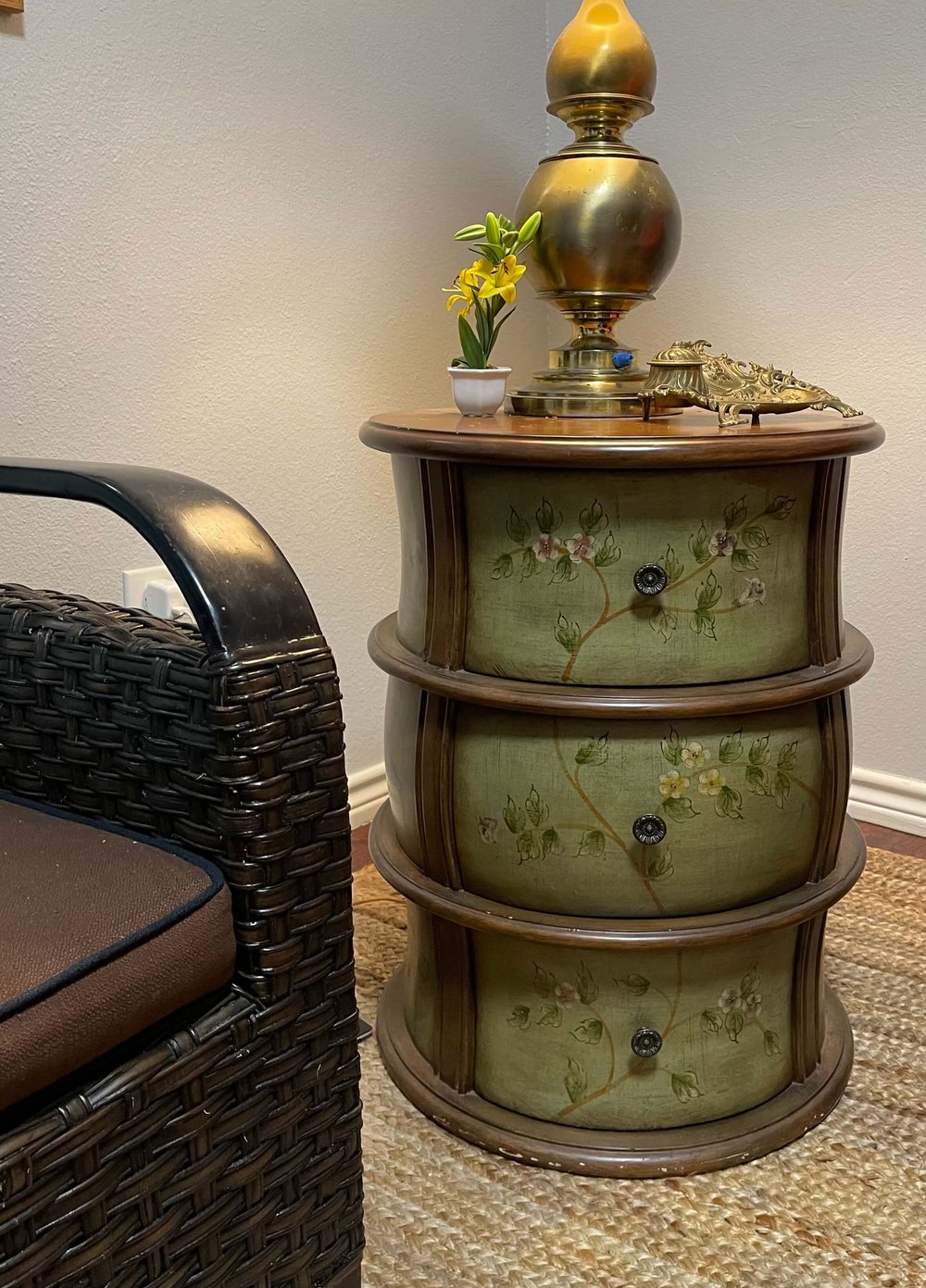
Here it is in one of the places she’s lived, at the end of her sofa. This sofa was in the garden room of her home, and its small footprint made it best to use in the living room of her previous assisted living facility.
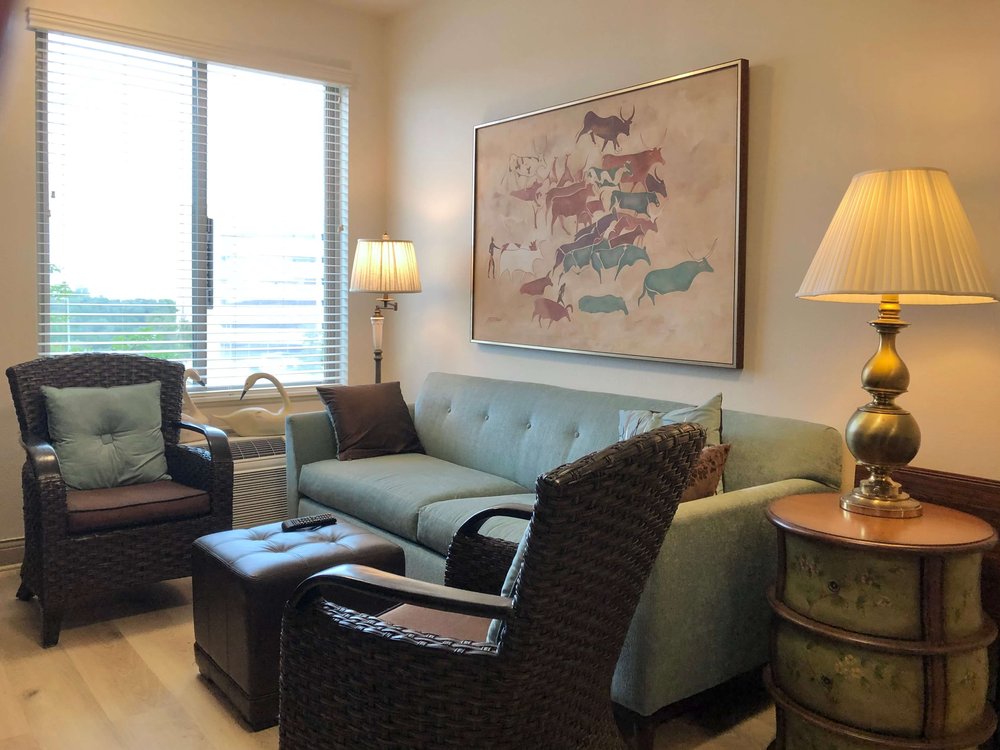
This end table with drawers was useful storage in the small living room of this assisted living apartment.
Shop some end tables and ottomans that have storage, below.

2) Tall, Vertical Furniture Pieces
Tall storage that doesn’t take up a big footprint is helpful. Tall, narrow bookshelves, corner cabinets, tall dressers, etc. are ideal for smaller spaces.
We bought this corner shelving piece for my MIL when she first moved out of her home and it has come in really handy and fits into almost any corner. It helps make room for her collection of shells which she really prizes and makes the space feel like home.
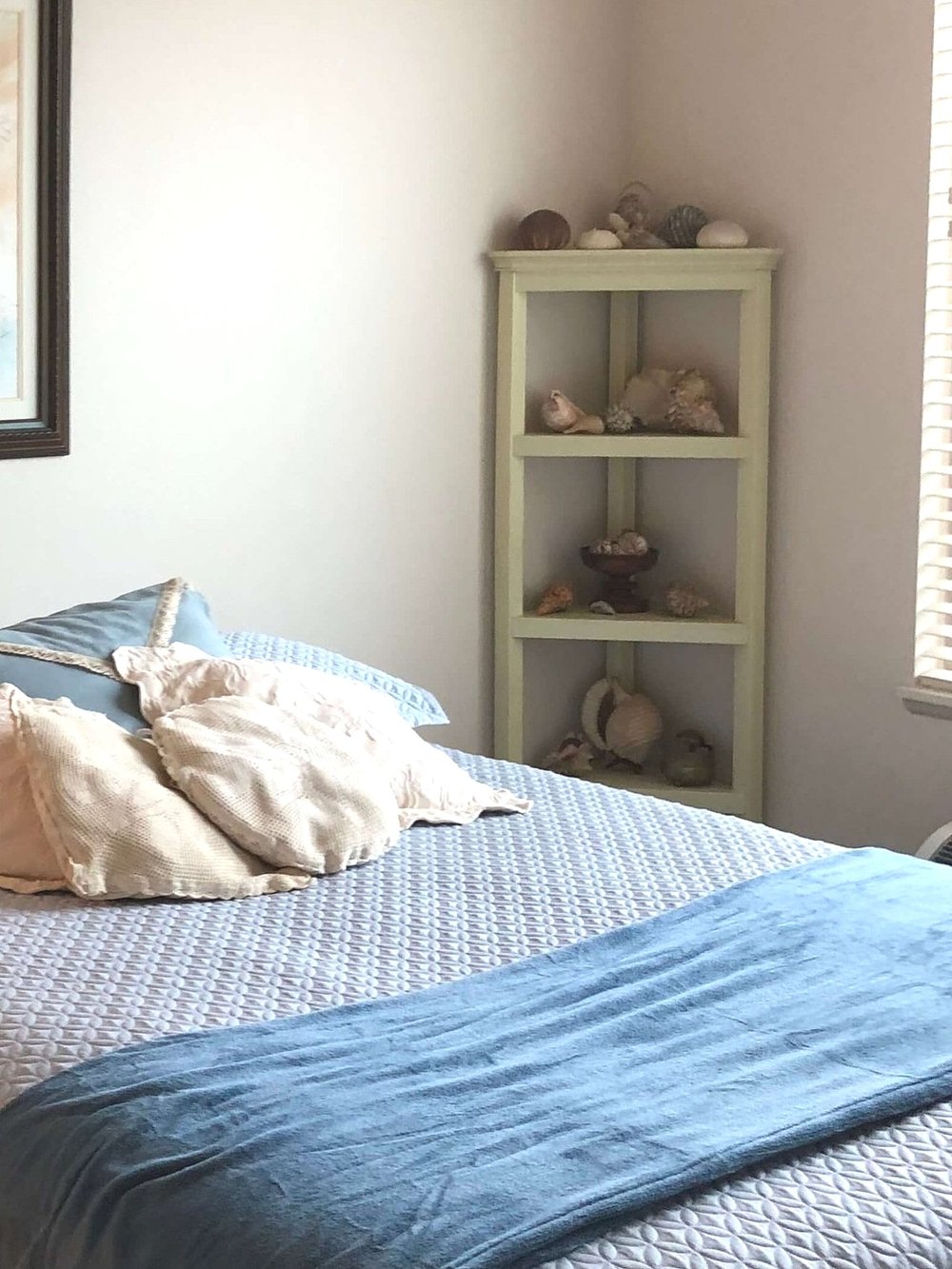
Corner cabinets are a good idea in small quarters like Assisted Living.
This antique hutch has actually come in really handy for her tv and has good storage too. She has a nice display shelf and storage below for misc. items. It was a prized furniture piece of hers and has sentimental value.

Antique hutch doubles as tv cabinet in Assisted Living situation.
IMPORTANT: Remember to attach these to the wall as people, at some point, might pull themselves up holding onto that piece. It would then come tumbling down on top of them.
It is surprising how furniture gets abused and wrecked in these places. Wheelchairs and walkers will bump into furniture, cleaning crews will hit the furniture with vacuum cleaners, etc.
Shop some tall corner cabinets below.

3) Comfortable, durable seating
While small footprints are helpful, when it comes to seating, it has to be comfortable. And seriously, the recliner is king and queen in senior living.
Spend the money here for a good one, it will follow you everywhere.
There are so many options, a “wall hugger” is a good idea for small spaces. Motorized recliners are desired by some and having the buttons on the side of the arm, I think, is better than having a remote. The remotes get lost and walk off very easily in these places.
Guest seating is something you will also want to have. Having one or two extra chairs for family members when they visit is important. These can be smaller, but a comfortable chair with seat and back cushions and arms will keep someone longer in a visit to your apartment than an uncomfy chair.
I think having a quality primary recliner and then a couple of smaller but comfortable arm chairs is better than trying to get a sofa into these small apartment-like quarters.
See a few examples of quality recliners below.

4) Lightweight pieces, not heavy and bulky
Large, heavy, bulky furniture is a problem and will likely be some of the first items to be gifted to the grandkids or sold for practically nothing :-( on Facebook marketplace.

While I do like tall, vertical storage pieces, an armoire like this is NOT a good idea in senior living.
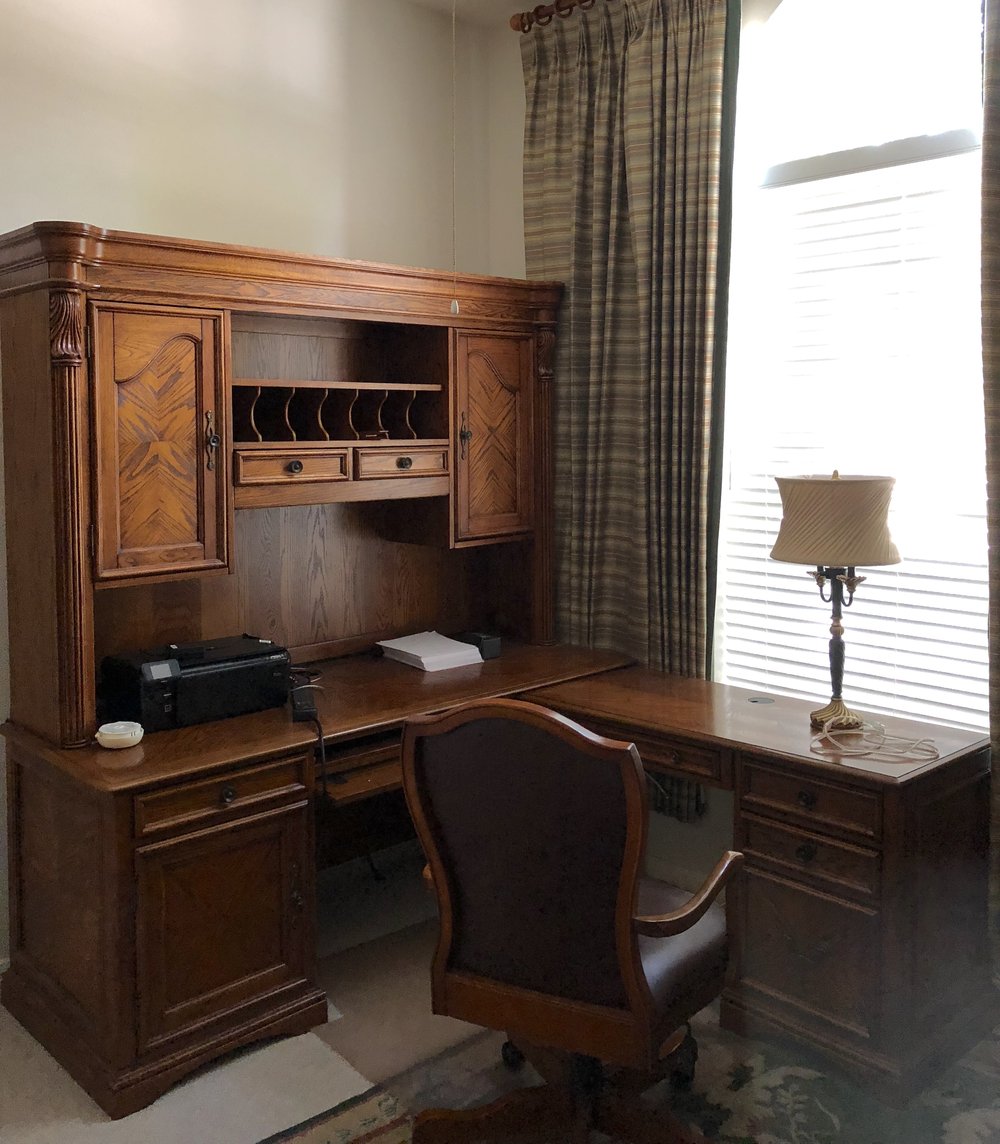
We sold this desk before moving my MIL into indenpendent living. Unless you have a second bedroom you can use as an office, this is just too big of a piece for a typical one bedroom unit.
Smaller scaled furniture pieces that are easy to move around and have a smaller footprint are better for downsized living.
The one exception here is a dresser. Tall dressers are great and usually there is a wall in the bedrooms for this piece of furniture. You can go big here to get maximum use of this wall. I have a long wall in my bedroom, and the dresser I bought for this space will work really well as I downsize.
First of all, it has a great finish that is really durable and forgiving. I can put a glass of water on it and it is fine.
Secondly, it has lots of drawers because of its size, 68” w x 36” tall, which is a little taller than an average dresser.
Third, it isn’t all that heavy and bulky with extra ornate details and such. It’s actually a trim, neat dresser, with all the space used for storage, not overlapping mouldings, etc.

5) Nightstands are key pieces of furniture
Invest in a good nightstand and you won’t regret it. It needs to be around 28-30” tall and a good sized width. Everything will end up on your nightstand, your pills, drinks, remotes, glasses, etc.
We ended up, as my mom aged, using one of her side tables from the living room as a nightstand. It had a drawer at the top and we put a basket underneath to keep books and her kindle, etc., but the surface area was nice and big.
Because it was square instead of rectangular, it was 24” x 24” and 28” high, then it extended out further into the room. That turned out to be handy when she had her adjustable bed, as that kind of makes a regular 18” - 20” deep nightstand less accessible and behind you when you are propped up in the bed.
It’s kind of hard to explain, but really that deeper table there was much more useful than a normal nightstand would have been.

My mom’s favorite chair and her “side table” nightstand went with her to assisted living. We found the deeper dimension of the side table useful for her, although more drawers would have been nice too.
Now, the side table was a good quality piece of furniture, but it was all wood and the top took a lot of use and abuse over the last years there. Mostly water glasses left or spilled, etc.
Therefore, I recommend a durable top or finish if possible. You can always put a piece of tempered glass with a polished edge, cut to fit, on the top of a nightstand.
Here’s a handy nightstand from Ballard Design with a charging drawer and an additional pull out shelf.

6) Furniture that does double duty
As with an ottoman stool or an end table with drawers, think of other furniture pieces that could do double duty. In the first place my MIL lived, she had room for her table, which also was where she put a laptop computer, when she could still use it.
This type of table below, from Ballard Design, would be handy for eating, writing a letter or notes, playing a game or working a puzzle, and then a laptop or writing papers could be kept underneath.
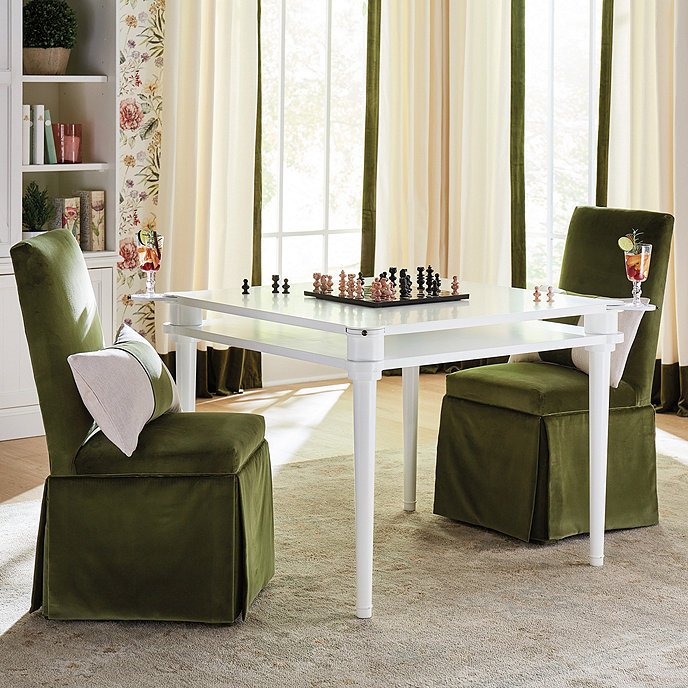
7) Bathroom Over-The-Toilet Cabinet
There is hardly any storage in an assisted living bathroom. My mother’s memory care place probably had the most with one small drawer, but in every single scenario I’ve helped move the moms into and in units I’ve toured, there is not much of anything.
They all need this valuable additional item, an over-the-toilet cabinet. It is necessary for toiletries, washcloths, hand towels, etc.
Here’s the situation….. the floor space needs to be more open. They might not have a bathroom cabinet below the sink because of wheelchair accessibility. Sometimes they have a small medicine cabinet, sometimes they don’t.
I don’t recommend a cabinet that stands on the floor, because they will need that space for manipulation of walkers and wheelchairs, etc. AND they will likely need a basket or something near the toilet for incontinence products.
Basically, in this small space, you need to use the wall for this type of storage.
Here are a few examples below.

Related Post
Here is a good description of how we helped my MIL downsize from her home into senior living about 5 years ago.
